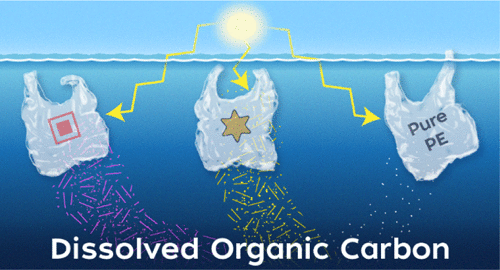当前位置:
X-MOL 学术
›
Environ. Sci. Technol.
›
论文详情
Our official English website, www.x-mol.net, welcomes your feedback! (Note: you will need to create a separate account there.)
Plastic Formulation is an Emerging Control of Its Photochemical Fate in the Ocean
Environmental Science & Technology ( IF 11.4 ) Pub Date : 2021-09-08 , DOI: 10.1021/acs.est.1c02272 Anna N Walsh 1, 2 , Christopher M Reddy 1 , Sydney F Niles 3 , Amy M McKenna 3, 4 , Colleen M Hansel 1 , Collin P Ward 1
Environmental Science & Technology ( IF 11.4 ) Pub Date : 2021-09-08 , DOI: 10.1021/acs.est.1c02272 Anna N Walsh 1, 2 , Christopher M Reddy 1 , Sydney F Niles 3 , Amy M McKenna 3, 4 , Colleen M Hansel 1 , Collin P Ward 1
Affiliation

|
Sunlight exposure is a control of long-term plastic fate in the environment that converts plastic into oxygenated products spanning the polymer, dissolved, and gas phases. However, our understanding of how plastic formulation influences the amount and composition of these photoproducts remains incomplete. Here, we characterized the initial formulations and resulting dissolved photoproducts of four single-use consumer polyethylene (PE) bags from major retailers and one pure PE film. Consumer PE bags contained 15–36% inorganic additives, primarily calcium carbonate (13–34%) and titanium dioxide (TiO2; 1–2%). Sunlight exposure consistently increased production of dissolved organic carbon (DOC) relative to leaching in the dark (3- to 80-fold). All consumer PE bags produced more DOC during sunlight exposure than the pure PE (1.2- to 2.0-fold). The DOC leached after sunlight exposure increasingly reflected the 13C and 14C isotopic composition of the plastic. Ultrahigh resolution Fourier transform ion cyclotron resonance mass spectrometry revealed that sunlight exposure substantially increased the number of DOC formulas detected (1.1- to 50-fold). TiO2-containing bags photochemically degraded into the most compositionally similar DOC, with 68–94% of photoproduced formulas in common with at least one other TiO2-containing bag. Conversely, only 28% of photoproduced formulas from the pure PE were detected in photoproduced DOC from the consumer PE. Overall, these findings suggest that plastic formulation, especially TiO2, plays a determining role in the amount and composition of DOC generated by sunlight. Consequently, studies on pure, unweathered polymers may not accurately represent the fates and impacts of the plastics entering the ocean.
中文翻译:

塑料配方是对其在海洋中的光化学命运的新兴控制
阳光照射是对环境中塑料长期命运的控制,它将塑料转化为跨越聚合物、溶解和气相的含氧产品。然而,我们对塑料配方如何影响这些光产品的数量和组成的理解仍然不完整。在这里,我们表征了来自主要零售商的四个一次性消费聚乙烯 (PE) 袋和一个纯 PE 薄膜的初始配方和由此产生的溶解照片产品。消费 PE 袋子含有 15–36% 的无机添加剂,主要是碳酸钙 (13–34%) 和二氧化钛 (TiO 2; 1–2%)。相对于在黑暗中浸出(3 到 80 倍),阳光照射持续增加了溶解有机碳 (DOC) 的产生。所有消费 PE 袋在阳光照射下产生的 DOC 比纯 PE 多(1.2 到 2.0 倍)。在阳光照射后浸出的 DOC 越来越多地反映了塑料的13 C 和14 C 同位素组成。超高分辨率傅里叶变换离子回旋共振质谱显示,阳光照射大大增加了检测到的 DOC 公式的数量(1.1 到 50 倍)。含TiO 2的袋子光化学降解为组成最相似的 DOC,68-94% 的光产生的配方与至少一种其他 TiO 2 相同- 收纳袋。相反,在来自消费者 PE 的光致 DOC 中仅检测到 28% 的来自纯 PE 的光致配方。总的来说,这些发现表明塑料配方,尤其是 TiO 2,在阳光产生的 DOC 的数量和组成中起着决定性的作用。因此,对纯的、未风化的聚合物的研究可能无法准确反映塑料进入海洋的命运和影响。
更新日期:2021-09-21
中文翻译:

塑料配方是对其在海洋中的光化学命运的新兴控制
阳光照射是对环境中塑料长期命运的控制,它将塑料转化为跨越聚合物、溶解和气相的含氧产品。然而,我们对塑料配方如何影响这些光产品的数量和组成的理解仍然不完整。在这里,我们表征了来自主要零售商的四个一次性消费聚乙烯 (PE) 袋和一个纯 PE 薄膜的初始配方和由此产生的溶解照片产品。消费 PE 袋子含有 15–36% 的无机添加剂,主要是碳酸钙 (13–34%) 和二氧化钛 (TiO 2; 1–2%)。相对于在黑暗中浸出(3 到 80 倍),阳光照射持续增加了溶解有机碳 (DOC) 的产生。所有消费 PE 袋在阳光照射下产生的 DOC 比纯 PE 多(1.2 到 2.0 倍)。在阳光照射后浸出的 DOC 越来越多地反映了塑料的13 C 和14 C 同位素组成。超高分辨率傅里叶变换离子回旋共振质谱显示,阳光照射大大增加了检测到的 DOC 公式的数量(1.1 到 50 倍)。含TiO 2的袋子光化学降解为组成最相似的 DOC,68-94% 的光产生的配方与至少一种其他 TiO 2 相同- 收纳袋。相反,在来自消费者 PE 的光致 DOC 中仅检测到 28% 的来自纯 PE 的光致配方。总的来说,这些发现表明塑料配方,尤其是 TiO 2,在阳光产生的 DOC 的数量和组成中起着决定性的作用。因此,对纯的、未风化的聚合物的研究可能无法准确反映塑料进入海洋的命运和影响。



























 京公网安备 11010802027423号
京公网安备 11010802027423号